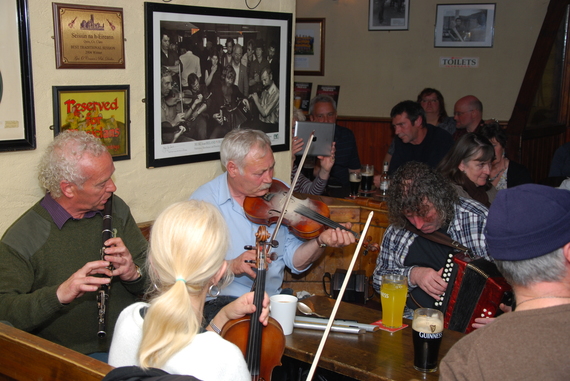Stepping back in Irish history a century from today, you'd find yourself in a season awash with quirky practices, most stemming from extreme superstition.
On New Year's Eve, the man or woman of the house would beat the walls with a Christmas loaf -- a measure to prevent against hunger in the year ahead. It was also considered bad luck to take food outside the home on this day; however, on New Year's Day, neighbors and friends would celebrate the arrival of the New Year by swapping little parcels of whatever leftovers they had to spare from the kitchen.
New Year's Eve was also a time to remember family members who had passed on during the year. A popular custom was to set a place for the deceased at the dinner table and leave the door unlocked so their spirit was welcome to return. Meanwhile, young ladies placed mistletoe under their pillows, hoping to dream of their future husbands.
Most of these old traditions, especially popular in rural areas, have died out. But there's one old custom that's making a comeback...
Jan. 6, the Epiphany on the Christian calendar, marking the end of Christmas for many around the world, has other significance in Irish society. Apart from the day most people remove their trees and pack away the decorations, it's traditionally known as Women's Christmas -- or "Nollaig na mBan" in the Gaelic language.
On this day, the women who had worked so hard during the season, waiting on their men and families, were allowed a day of rest, while the men pitched in to help around the house.
Women's Christmas was originally celebrated among the poorer classes. Women who worked as servants in the big houses and were needed to be on duty to serve all throughout this important season were given Jan. 6 as a holiday. Others who raised turkeys for the Christmas market would spend their earnings on the Christmas celebrations and keep whatever little remained for indulgences on Jan. 6.
As well as being exempt of their own household chores for the day, some would meet in the snug of the local public house to celebrate, laugh and gossip over glasses of stout and corned-beef sandwiches.
Though life is far easier for women these days, Women's Christmas celebrations are regaining popularity, and beyond the counties of Cork and Kerry, too, where the traditions were strongest.
Today's celebrations are less about taking a rest (I haven't heard of any ladies getting the day off) and more about getting together with female friends for a night of fun. Across the country, friends gather for dinner or drinks in bars and restaurants. In the last couple of years, hotels in Cork and Dublin have begun offering special packages for Women's Christmas.
A few years ago, I received my first invitation to a Women's Christmas party. A friend had 30 women around to her home to enjoy homemade curry, wine, and a surprise appearance by a belly-dancer who led us all in Bollywood dance. Though not a corned-beef sandwich in sight, we shared the same high spirits as those hard-working Irish of a century ago who gathered in the snug.
